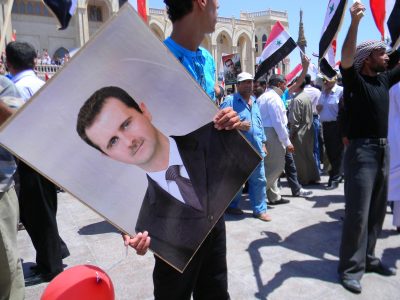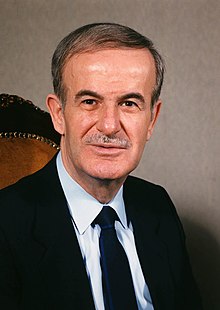Decades of US Attempts to Topple the Syrian Government

All Global Research articles can be read in 51 languages by activating the “Translate Website” drop down menu on the top banner of our home page (Desktop version).
To receive Global Research’s Daily Newsletter (selected articles), click here.
Visit and follow us on Instagram, Twitter and Facebook. Feel free to repost and share widely Global Research articles.
***
Syria has for the vast majority of the post-World War II period been considered by United States governments as a staunch enemy. In more recent decades, Washington has attempted without ultimate success to isolate and overthrow the Assad dynasty in Syria’s capital Damascus.
Image on the right: Hafez al-Assad (Licensed under public domain)

In March 1971 the Syrian Air Force general, Hafez al-Assad, took power in the country. That same year General Assad consented to the USSR establishing a naval facility at the strategically important Syrian city of Tartus, which rests on the Mediterranean Sea. Developments like these caused significant concern in Washington.
During the Yom Kippur War in October 1973 Israel, with strong US support, scored a military victory against the Soviet Union-backed Syria and Egypt in a conflict which lasted for less than 3 weeks. Following this setback General Assad crushed a number of revolts in Syria, engineered primarily by the Sunni-Salafi Muslim Brotherhood, a pan-Islamic organisation vehemently opposed to Assad’s secularist government.
The best known of these Muslim Brotherhood rebellions was the February 1982 Hama revolt, in western Syria, which rumbled on for almost a month. It resulted in many hundreds if not thousands of deaths, including extensive civilian casualties. President Assad’s military secured a decisive triumph against the Muslim Brotherhood, by ruthlessly suppressing the insurgency. The Hama revolt may well have been encouraged by “the intelligence services of the United States and Turkey” according to Moniz Bandeira, the Brazilian political scientist.
After the 1982 rebellion Bandeira wrote that the Syrian president “stabilized the country” while “The continuing efforts by the United States to erode the regime in Syria pushed president Hafez al-Assad more and more toward an alliance with the Soviet Union”.
The process of the USSR’s disintegration, starting in the late 1980s, was not at all a welcome scenario for General Assad. During the remainder of his life, he had little choice but to readjust his foreign policy in the 1990s to accommodate the Americans. Assad provided support to the Western powers during the 1990-91 Gulf War versus Saddam Hussein, after the Iraqi dictator had invaded neighbouring Kuwait on 2 August 1990.
The Chicago Tribune reported on 12 March 1991,
“The Bush administration [George H. W. Bush] credits Syria with helping to restrain terrorist groups, that might have targeted U.S. and other Western interests during the war with Iraq. The newly forged relationship with the U.S. provides a balance in Syrian foreign policy that had been lacking”.
A “balance” meaning that the Russians had disappeared, for now. The majority of Syrians were displeased with the warmer US-Syrian relations in the 1990s. They had not forgotten the US-led coup d’etat that deposed president Shukri al-Quwatli in Damascus in 1949; nor the failed attempts at further CIA coups in 1956 and 1957, once more against Quwatli, who is considered a founding father of modern Syria.
Ordinary Syrians were unhappy with Washington’s ongoing support for Israel, and with the attempts to exclude Syria from the Middle East peace process. Much of the Syrian populace was doubtful whether Washington actually wanted to improve relations – taking into account that General Assad continued, into the 1990s, his refusal to capitulate to American strategic and economic interests.
By the late 1990s General Assad’s health was rapidly deteriorating. He succumbed to a heart attack at age 69 on 10 June 2000, after 29 years in power. On 17 July 2000 his son Bashar al-Assad, at age 34, took over the presidency in Damascus, as he had been preparing to do for some time in agreement with his father. At the start of this century, Bashar al-Assad was a colonel in the elite Syrian Republican Guard, having undertaken years of military training.
The maintenance of the Assad dynasty was not greeted with fanfare in Washington. When George W. Bush became president in January 2001, his administration that same year started planning a military attack against Syria, in order to remove Assad and replace him with a pro-Western and pro-Israeli leader.
American general Wesley Clark, a former NATO supreme commander, recalled how he had visited the Pentagon in late 2001, and was shown a classified memorandum by an unnamed US general. As Clark later remembered, the Pentagon memo stated that the US Armed Forces were “going to take out seven countries in five years, starting with Iraq and then Syria, Lebanon, Libya, Somalia, Sudan and, finishing off, Iran”.
The invasion of Syria was to almost immediately follow a successful American intervention in Iraq. With the US military in October 2001 having already assailed Afghanistan – an invasion planned well before the 9/11 atrocities against America – less than 18 months later the Bush administration launched a military offensive in Iraq on 20 March 2003; so as to reassert US hegemony over the Middle East and to ensure control over Iraq’s oil reserves.
The go-ahead for the US invasion of Iraq, bolstered by Tony Blair’s hawkish regime in London, had in part been made possible with the support of the Western mainstream press, which as usual was generally pro-war. American plans to attack Iraq also predated 9/11 by months, to March 2001, just a few weeks into Bush’s presidency.
Bandeira revealed,
“Documents from March 2001, which the US Department of Commerce was forced to declassify in mid-2003, as a result of a suit filed by the Sierra Club (an environmentalist organization) and Judicial Watch, confirmed that the Task Force headed by vice-president Dick Cheney had developed two maps plotting the oil fields, pipelines, refineries and terminals, and two maps detailing the projects and the companies that wanted to manage these resources in Iraq”.
In early April 2003 Saddam Hussein was ousted from power, with the capital Baghdad falling to US-led soldiers on 9 April. Iraq itself had been devastated by years of Western sanctions prior to the invasion, and was not far from being a defenceless and broken country. Shortly after Baghdad’s capture the US Secretary of Defence, Donald Rumsfeld, initiated contingency plans to extend the military assault to Syria, which shares a near 400 mile eastern border with Iraq.
However, president Bush was warned that starting another war so soon could cause problems in the “special relationship” with Britain. The US Secretary of State, Colin Powell, said in mid-April 2003 that Washington does not intend to attack another country “right now”. The UN Secretary General, Kofi Annan, said that should the war be extended to Syria the entire Middle East could be destabilised.
Having secured a military victory in Iraq, the Americans still had to occupy and subdue the country, in order most importantly to copper-fasten US control over Iraq’s oil; this would take time, if it could be achieved at all. Assad was the first Arab leader, other than Saddam Hussein, to condemn the Anglo-American attack on Iraq. Towards the end of March 2003 Assad predicted,
“The United States and Britain will not be able to control all of Iraq. There will be much tougher resistance… and we doubt that they will succeed”.
The Anglo-American aggressors were indeed unable to control all of Iraq. By 2008, now near the end of Bush’s presidency, it was clear that Washington had in fact suffered a major defeat. Facing large-scale Iraqi popular resistance, the Bush administration had to give up its claims to military bases in Iraq and privileges for US investors in the country’s rich energy system.
In 2008 a US invasion of Syria was back on the agenda largely because of Israel; on the pretexts of preventing weapons trafficking from Syria to the Lebanese-based militant group Hezbollah, a sworn enemy of Israel, along with the training of Hezbollah militants in Syria and the construction of a nuclear reactor in Deir ez-Zor, eastern Syria.
The US State Department had since 2005 been furnishing anti-Assad elements in Syria with millions of dollars. This money encouraged the instigation of protests in Syria against Assad. Not only did the US government wish to topple the Syrian president, but they wanted to sever Syria’s tightening naval relations with Russia, and to break the partnerships that Assad had formed with Iran, Hezbollah and Hamas in Palestine.
Yet Robert Gates, the US Secretary of Defence since 2006 and former CIA Director, did not think a US offensive against Syria was a good idea. He rightly believed that American credibility was damaged with the debacle of the occupation of Iraq, in which Saddam’s mythical Weapons of Mass Destruction (WMDs) were never found. Moreover, Gates felt an invasion of Syria would meet with the disapproval of the American public and incite unrest in Europe and the Middle East, while undermining continued US military actions in Afghanistan and Iraq.
President Bush therefore abandoned the idea of attacking Syria, despite consistent pressure from his vice-president Dick Cheney. Bandeira described Cheney as “the warmonger who had similarly manipulated the invasion of Iraq to deliver profits to Halliburton, the corporation he had presided and with which he maintained close ties, just as with other military-industrial contractors of the Pentagon and the Big Oil Companies”.
Following Barack Obama’s assumption to power in Washington in January 2009, the threat of an American intervention in Syria continued to hover over Assad. As president Obama was settling into office, Assad refused to sanction through Syrian territory the South Pars/North Dome Pipeline, infrastructure which was planned to pass through Saudi Arabia, Jordan, Syria and Turkey; and which would have supplied natural gas to the markets of Europe, a continent dominated by NATO, the expansionist US-led military organisation.
In withholding his approval for the pipeline, Assad was undoubtedly defending the interests of his ally, Russia. Such policies of course disturbed both Washington and Brussels. A principal goal of the Obama administration, supported by France and Britain, was to take control of the Mediterranean and to politically isolate Iran, a Syrian ally, in addition to restricting Russian and Chinese influence in the Middle East and North Africa.
By 2012 Russia was planning to reform and expand its naval base in Tartus, Syria, so that it could receive large Russian warships, thereby safeguarding Moscow’s presence in the Mediterranean; along with a Russian-controlled air base at the Syrian city of Latakia, about 60 miles north of Tartus. Russia had further planned to erect naval bases in Libya and Yemen.
Summarising US-NATO imperialist thinking Bandeira wrote,
“The fall of the Bashar al-Assad regime, after the toppling of Muammar Gaddafi in Libya by NATO forces, would suppress the presence of Russia and its naval bases in Syria (Tartus and Latakia); cut off supply routes for weapons to Hezbollah, the Shia stronghold against Israeli ventures into southern Lebanon; contain the Chinese advance on oil resources; and completely isolate and strangle Iran, with the consequent elimination of the (Shia) Islamic government of Mahmoud Ahmadinejad”.
The triumvirate of America, France and Britain attacked oil rich Libya on 19 March 2011, paving the way for the toppling of the country’s long-time leader, Muammar Gaddafi, who was killed on 20 October 2011. The NATO states were assisted in eliminating Gaddafi by Al Qaeda and Libyan terrorists, along with the special forces of Qatar, the UAE and other countries. Within the space of a few years Libya, which in 2010 had by some distance the best living standards in Africa, was splintered into warring parties as conditions for its population dropped sharply. Libya is yet to recover.
Obama’s government, with the support of NATO members France, Britain, Germany and Portugal, then attempted to repeat the subterfuge at the United Nations (UN) regarding Syria, which they had used to proceed with military actions against Libya. On 4 October 2011, the Western powers presented at the UN a proposal for a resolution based on the “Responsibility to Protect”.
Russia and China, aware that NATO wanted to bomb Syria and remove Assad, vetoed the resolution. Bandeira outlined,
“The pretext of the Responsibility to Protect resolution, as it was used in the bombing of Libya, had become the template to justify NATO interventions as the military instrument of the ultra-imperialist cartel led by the United States, Great Britain and France”.
Obama set out to stealthily incite war against Assad. On 17 August 2011 the US president said, “For the sake of the Syrian people, the time has come for President Assad to step aside”. It was not the last occasion that Obama would call for Assad to go. The war in Syria was no ordinary conflict between two opposing sides, but it involved an array of factions, many of them outright extremists and jihadists.
In the fight against Assad’s government, Al Qaeda, America, France and Britain were effectively on the same side. The Franco-American-British powers participated in the war, directly and indirectly, more than any other states, with the assistance of Western allies like Turkey, Saudi Arabia and Qatar. By late 2012, the Obama administration knew “from classified assessments” that most Western weaponry sent through Saudi Arabia and Qatar, and then on to Syria, ended up in the possession of Islamic fundamentalists who were trying to destroy Assad’s government.
The jihadists wanted to restore the Great Caliphate in Greater Syria (Bilad al-Sham) between the Euphrates River and the Mediterranean Sea. With CIA assistance, the Persian Gulf states and Turkey continued increasing military aid to the extremists in Syria, sending them weaponry dropped from the air.
*
Note to readers: Please click the share buttons above or below. Follow us on Instagram, Twitter and Facebook. Feel free to repost and share widely Global Research articles.
Shane Quinn obtained an honors journalism degree. He is interested in writing primarily on foreign affairs, having been inspired by authors like Noam Chomsky. He is a Research Associate of the Centre for Research on Globalization (CRG).
Sources
David W. Lesch, When the Relationship Went Sour: Syria and the Eisenhower Administration, Presidential Studies Quarterly, Winter 1998, Published by: Wiley, Jstor
Luiz Alberto Moniz Bandeira, The World Disorder: US Hegemony, Proxy Wars, Terrorism and Humanitarian Catastrophes (Springer; 1st ed., 4 Feb. 2019)
Ray Moseley, “Syria’s support of U.S. in Gulf War Paying Dividends”, Chicago Tribune, 12 March 1991
George Arney, “US ‘planned attack on Taleban’”, BBC, 18 September 2001
Meredith Reid Sarkees and Stephen Zunes, Disenchantment with the ‘New World Order’: Syria’s Relations with the United States, International Journal, Spring 1994, Published by: Sage Publications Ltd. on behalf of the Canadian International Council, Jstor
Democracy Now!, “Gen. Wesley Clark Weighs Presidential Bid: ‘I Think About It Every Day’”, 2 March 2007
Robert Stevens, “BBC was most pro-war of British networks”, World Socialist Web Site, 10 July 2003
Luiz Alberto Moniz Bandeira, The Second Cold War: Geopolitics and the Strategic Dimensions of the USA (Springer 1st ed., 23 June 2017)
CNN, “No war plans for Syria: U.S.”, 16 April 2003
Alissa J. Rubin, “Syria Sees Threat of Force Behind Rumsfeld Remark”, Los Angeles Times, 30 March 2003
Scott Wilson and Joby Warrick, “Assad must go, Obama says”, The Washington Post, 18 August 2011


